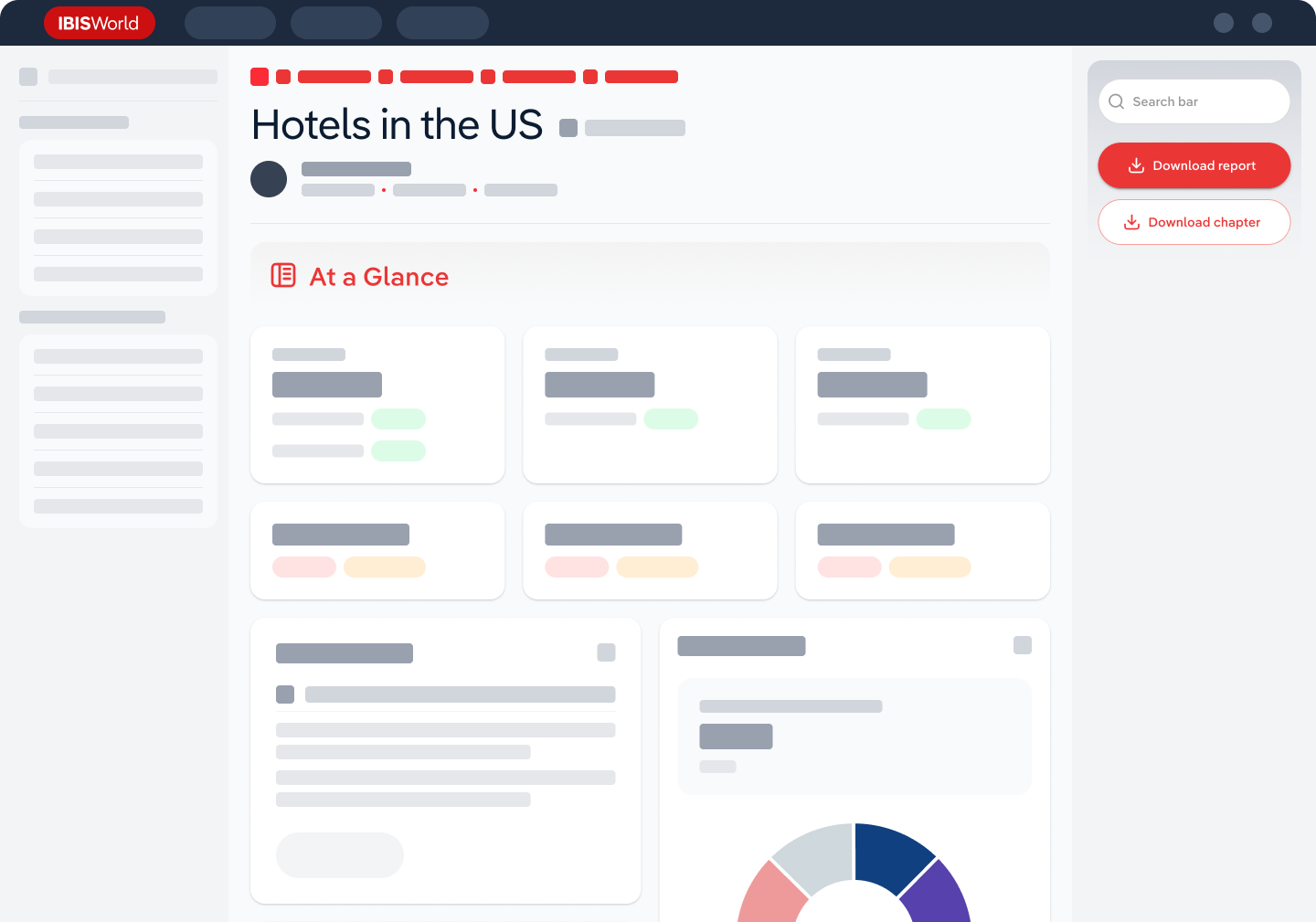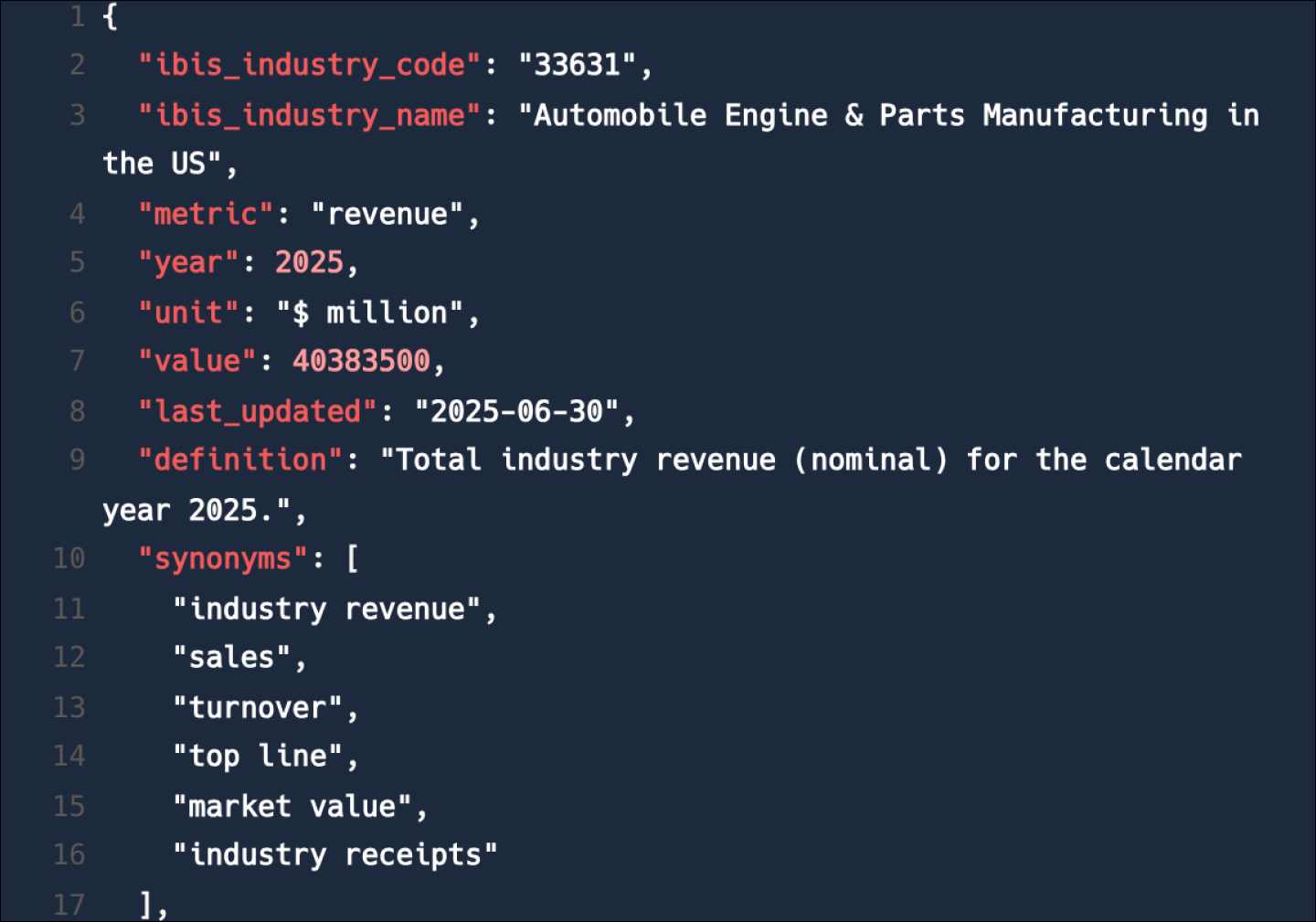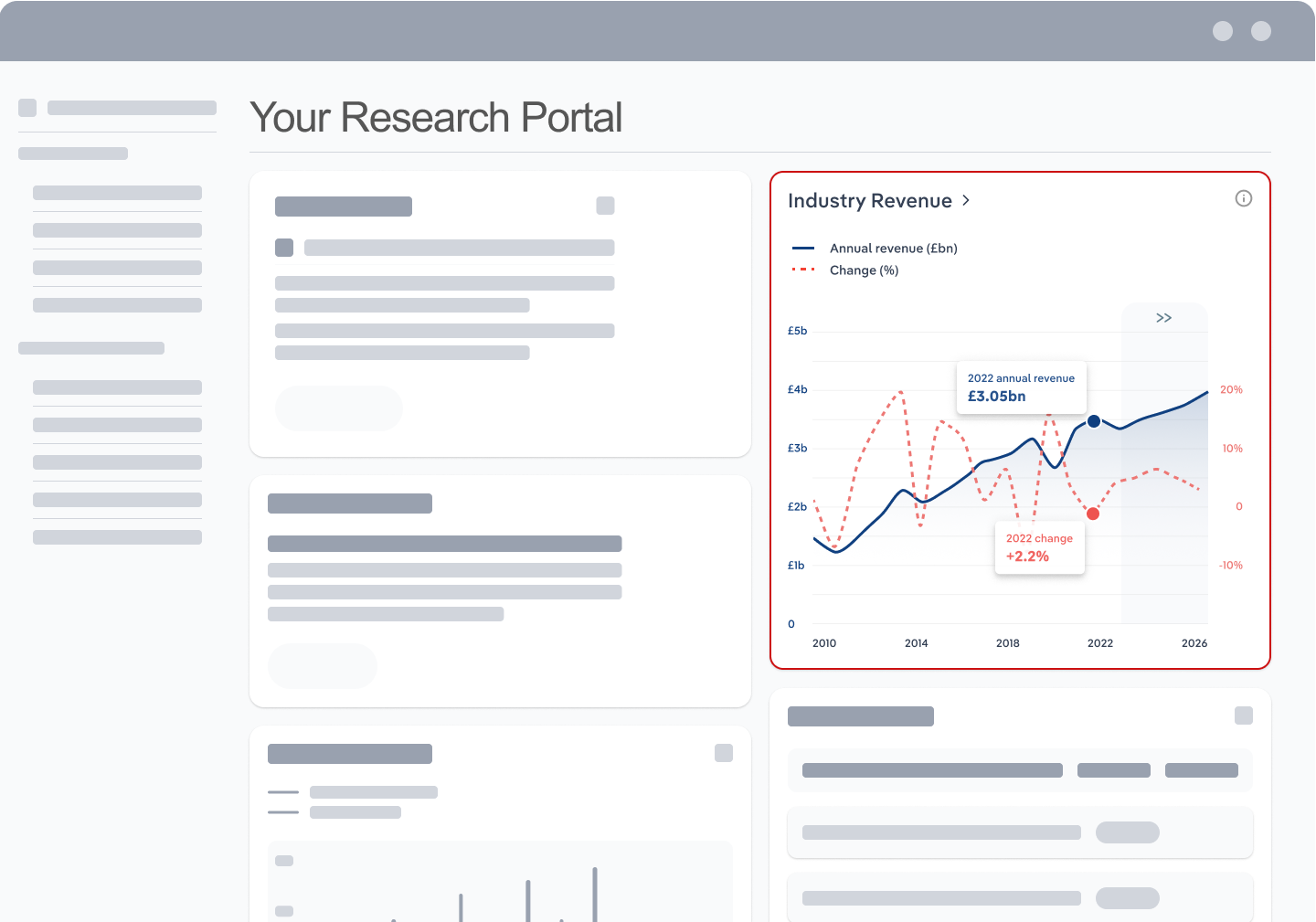Industry Statistics and Trends
Market size and recent performance (2015-2030)
Industry revenue has grown at a CAGR of 2.1 % over the past five years, to reach an estimated $1.0bn in 2025.
Trends and Insights
Technological innovations drive efficiency and versatility
- The transition to digital embroidery has revolutionized detail precision, often exceeding the quality of hand-made patterns. This technology ensures precision and facilitates easy scaling and uniformity across mass-produced items, which is crucial for production efficiency. Equipped with cutting-edge software, these machines accelerate production while maintaining consistent quality. They provide precise stitching and alignment for personalized products, with advanced sensors and auto-tensioning features ensuring uniformity even in complex designs. Intuitive controls reduce training time, allowing businesses to scale operations swiftly.
- Additional trends and insights available with purchase
Industry outlook (2025-2030)
Market size is projected to decline over the next five years.
Trends and Insights
Tariffs and disposable income influence demand for embroidery services
- Demand for commercial embroidery services is being shaped by a mix of economic factors, including changes in trade policies and shifts in disposable income levels. Anticipated growth in demand from apparel manufacturing, coupled with broader growth of per capita disposable income, will provide a generate demand for embroidery services.
Biggest companies in the Commercial Embroidery Services in the US
| Company | Market Share (%)
2025 | Revenue
2025 | Profit
2025 | Profit Margin (%)
2025 |
|---|
There are no companies that hold a market share exceeding 5% in the Commercial Embroidery Services in the US industry.
Products & Services Segmentation
Industry revenue is measured across several distinct product and services lines, including Standard embroidery services, 3D embroidery services and Applique embroidery services. Standard embroidery services is the largest segment of the Commercial Embroidery Services in the US.
Trends and Insights
Expensive production costs dampen consumer interest in standard embroidery services
- Standard embroidery services involve the application of embroidery designs on various clothing items, catering primarily to consumers interested in custom embellishments. These services offer a range of design possibilities, from simple monograms to intricate patterns. Despite the inherent value they provide, they're impacted significantly by production costs, which influence consumer demand.
- More insights available in the full report
Table of Contents
About this industry
Industry definition
Commercial embroiderers provide embroidery services to clients. The embroidery process involves using a sewing machine to create predetermined patterns on clothing and other textiles. These patterns can be designed using specialist software. Services are often sold to companies, teams and clubs for shirts, uniforms and other paraphernalia.
What's included in this industry?
Products and services covered in the Commercial Embroidery Services industry in the United States include Standard embroidery services, Applique embroidery services, 3D embroidery services and Chenille embroidery services.Companies
Companies covered in the Commercial Embroidery Services industry in the United States include .Purchase this report to view all major companies in this industry.
Related Terms
Related terms covered in the Commercial Embroidery Services industry in the United States include generation y, vertical integration, offshoring, embroidery head and outsource.Industry Code
NAICS 314999 - Commercial Embroidery Services in the US
Performance
Get an indication of the industry's health through historical, current and forward-looking trends in the performance indicators that make or break businesses.
Analyst insights
Technological advancements in embroidery are upping the game for precision and efficiency. With multi-needle machines and centralized systems, businesses can handle complex d...
In this chapter (4)
- Current Performance
- Outlook
- Volatility
- Life Cycle
Key metrics
- Annual Revenue, Recent Growth, Forecast, Revenue Volatility
- Number of Employees, Recent Growth, Forecast, Employees per Business, Revenue per Employee
- Number of Businesses, Recent Growth, Forecast, Employees per Business, Revenue per Business
- Total Profit, Profit Margin, Profit per Business
Charts
- Revenue, including historical (2015-2024) and forecast (2025-2030)
- Employees, including historical (2015-2024) and forecast (2025-2030)
- Businesses, including historical (2015-2024) and forecast (2025-2030)
- Profit, including historical (2015-2025)
- Industry Volatility vs. Revenue Growth
- Industry Life Cycle
Detailed analysis
- Trends in supply, demand and current events that are driving current industry performance
- Expected trends, economic factors and ongoing events that drive the industry's outlook
- Key success factors for businesses to overcome volatility
- How contribution to GDP, industry saturation, innovation, consolidation, and technology and systems influence the industry's life cycle phase.
Products and Markets
Learn about an industry's products and services, markets and trends in international trade.
Analyst insight
Consistent popularity of caps and hats bolsters popularity of 3D embroidery services. As more downstream customers continue to look for new caps and hats, they will want qual...
In this chapter
- Products & Services
- Major Markets
Key metrics
- Largest market segment and value in 2025
- Product innovation level
Charts
- Products & services segmentation in 2025
- Major market segmentation in 2025
Detailed analysis
- Trends impacting the recent performance of the industry's various segments
- Innovations in the industry's product or service offering, specialization or delivery method
- Key factors that successful businesses consider in their offerings
- Buying segments and key trends influencing demand for industry products and services
Geographic Breakdown
Discover where business activity is most concentrated in an industry and the factors driving these trends to find opportunities and conduct regional benchmarking.
Analyst insights
Large population centers bolster establishment demand. Regions that house a significant portion of the domestic population will provide operators with access to a larger cust...
In this chapter (1)
- Business Locations
Charts
- Share of revenue, establishment, wages and employment in each state
- Share of population compared to establishments in each region in 2025
Tables
- Number and share of establishments in each state in 2025
- Number and share of revenue each state accounts for in 2025
- Number and share of wages each state accounts for in 2025
- Number and share of employees in each state in 2025
Detailed analysis
- Geographic spread of the industry across North America, and trends associated with changes in the business landscape
- Key success factors for businesses to use location to their advantage
Competitive Forces
Get data and insights on what's driving competition in an industry and the challenges industry operators and new entrants may face, with analysis built around Porter's Five Forces framework.
Analyst insights
Maintaining competitive market pricing enhances internal competition. Operators that set a consistent price for embroidery services could attract a larger quantity of custome...
In this chapter (4)
- Concentration
- Barriers to Entry
- Substitutes
- Buyer & Supplier Analysis
Key metrics
- Industry concentration level
- Industry competition level and trend
- Barriers to entry level and trend
- Substitutes level and trend
- Buyer power level and trend
- Supplier power level and trend
Charts
- Market share concentration among the top 4 suppliers from 2020-2025
- Supply chain including upstream supplying industries and downstream buying industries, flow chart
Detailed analysis
- Factors impacting the industry’s level of concentration, such as business distribution, new entrants, or merger and acquisition activity.
- Key success factors for businesses to manage the competitive environment of the industry.
- Challenges that potential industry entrants face such as legal, start-up costs, differentiation, labor/capital intensity and capital expenses.
- Key success factors for potential entrants to overcome barriers to entry.
- Competitive threats from potential substitutes for the industry’s own products and services.
- Key success factors for how successful businesses can compete with substitutes.
- Advantages that buyers have to keep favorable purchasing conditions.
- Advantages that suppliers have to maintain favorable selling conditions.
- Key success factors for how businesses can navigate buyer and supplier power.
Companies
There are no companies that hold a market share exceeding 5% in the Commercial Embroidery Services in the US industry.
Analyst insights
No major companies dominate commercial embroidery services. The prevalence of localized operations and customers exacerbates fragmentation and creates a difficult path to sca...
External Environment
Understand the demographic, economic and regulatory factors that shape how businesses in an industry perform.
Analyst insights
Dampened demand from apparel manufacturing harms core revenue channels. Since servicers are highly dependent on growth in apparel manufacturing demand to facilitate commercia...
In this chapter
- External Drivers
- Regulation & Policy
- Assistance
Key metrics
- Regulation & policy level and trend
- Assistance level and trend
Charts
- Regulation & Policy historical data and forecast (2015-2030)
- Assistance historical data and forecast (2015-2030)
Detailed analysis
- Demographic and macroeconomic factors influencing the industry, including Regulation & Policy and Assistance
- Major types of regulations, regulatory bodies, industry standards or specific regulations impacting requirements for industry operators
- Key governmental and non-governmental groups or policies that may provide some relief for industry operators.
Financial Benchmarks
View average costs for industry operators and compare financial data against an industry's financial benchmarks over time.
Analyst insights
Volatility in the economy harms profitability. If economic conditions worsen and consumers’ purchasing power diminishes, it will eat into embroidery servicers’ demand, harmin...
In this chapter
- Cost Structure
- Financial Ratios
- Key Ratios
Key metrics
- Profit margin, and how it compares to the sector-wide margin
- Average wages, and how it compares to the sector-wide average wage
- Largest cost component as a percentage of revenue
- Industry average ratios for days' receivables, industry coverage and debt-to-net-worth ratio
Charts
- Average industry operating costs as a share of revenue, including purchases, wages, depreciation, utilities, rent, other costs and profit in 2025
- Average sector operating costs as a share of revenue, including purchases, wages, depreciation, utilities, rent, other costs and profit in 2025
- Investment vs. share of economy
Data tables
- Industry Multiples (2018-2023)
- Industry Tax Structure (2018-2023)
- Income Statement (2018-2023)
- Balance Sheet (2018-2023)
- Liquidity Ratios (2018-2023)
- Coverage Ratios (2018-2023)
- Leverage Ratios (2018-2023)
- Operating Ratios (2018-2023)
- Cash Flow & Debt Service Ratios (2015-2030)
- Revenue per Employee (2015-2030)
- Revenue per Enterprise (2015-2030)
- Employees per Establishment (2015-2030)
- Employees per Enterprise (2015-2030)
- Average Wage (2015-2030)
- Wages/Revenue (2015-2030)
- Establishments per Enterprise (2015-2030)
- IVA/Revenue (2015-2030)
- Imports/Demand (2015-2030)
- Exports/Revenue (2015-2030)
Detailed analysis
- Trends in the cost component for industry operators and their impact on industry costs and profitability
Key Statistics
Industry Data
Data Tables
Including values and annual change:
- Revenue (2015-2030)
- IVA (2015-2030)
- Establishments (2015-2030)
- Enterprises (2015-2030)
- Employment (2015-2030)
- Exports (2015-2030)
- Imports (2015-2030)
- Wages (2015-2030)
Top Questions Answered
Unlock comprehensive answers and precise data upon purchase. View purchase options.
What is the market size of the Commercial Embroidery Services industry in the United States in 2025?
The market size of the Commercial Embroidery Services industry in the United States is $1.0bn in 2025.
How many businesses are there in the Commercial Embroidery Services industry in the United States in 2025?
There are 988 businesses in the Commercial Embroidery Services industry in the United States, which has grown at a CAGR of 1.1 % between 2020 and 2025.
How may import tariffs affect the Commercial Embroidery Services industry in the United States?
The Commercial Embroidery Services industry in the United States is unlikely to be materially impacted by import tariffs with imports accounting for a low share of industry revenue.
How may export tariffs affect the Commercial Embroidery Services industry in the United States?
The Commercial Embroidery Services industry in the United States is unlikely to be materially impacted by export tariffs with exports accounting for a low share of industry revenue.
Has the Commercial Embroidery Services industry in the United States grown or declined over the past 5 years?
The market size of the Commercial Embroidery Services industry in the United States has been growing at a CAGR of 2.1 % between 2020 and 2025.
What is the forecast growth of the Commercial Embroidery Services industry in the United States over the next 5 years?
Over the next five years, the Commercial Embroidery Services industry in the United States is expected to decline.
What does the Commercial Embroidery Services industry in the United States include?
Standard embroidery services and Applique embroidery services are part of the Commercial Embroidery Services industry in the United States.
How competitive is the Commercial Embroidery Services industry in the United States?
The level of competition is high and increasing in the Commercial Embroidery Services industry in the United States.
Methodology
How are IBISWorld reports created?
IBISWorld has been a leading provider of trusted industry research for over 50 years to the most successful companies worldwide. With offices in Australia, the United States, the United Kingdom, Germany and China, we are proud to have local teams of analysts that conduct research, data analysis and forecasting to produce data-driven industry reports.
Our analysts start with official, verified and publicly available sources of data to build the most accurate picture of each industry. Analysts then leverage their expertise and knowledge of the local markets to synthesize trends into digestible content for IBISWorld readers. Finally, each report is reviewed by one of IBISWorld’s editors, who provide quality assurance to ensure accuracy and readability.
IBISWorld relies on human-verified data and human-written analysis to compile each standard industry report. We do not use generative AI tools to write insights, although members can choose to leverage AI-based tools within the platform to generate additional analysis formats.
What data sources do IBISWorld analysts use?
Each industry report incorporates data and research from government databases, industry-specific sources, industry contacts, and our own proprietary database of statistics and analysis to provide balanced, independent and accurate insights.
Key data sources in the US include:
- US Census Bureau
- US Bureau of Labor Statistics
- US International Trade Commission
Analysts also use industry specific sources to complement catch-all sources, although their perspective may focus on a particular organization or representative body, rather than a clear overview of all industry operations. However, when balanced against other perspectives, industry-specific sources provide insights into industry trends.
These sources include:
- Industry and trade associations
- Industry federations or regulators
- Major industry players annual or quarterly filings
Finally, IBISWorld’s global data scientists maintain a proprietary database of macroeconomic and demand drivers, which our analysts use to help inform industry data and trends. They also maintain a database of statistics and analysis on thousands of industries, which has been built over our more than 50-year history and offers comprehensive insights into long-term trends.
How does IBISWorld forecast its data?
IBISWorld’s analysts and data scientists use the sources above to create forecasts for our proprietary datasets and industry statistics. Depending on the dataset, they may use regression analysis, multivariate analysis, time-series analysis or exponential smoothing techniques to project future data for the industry or driver. Additionally, analysts will leverage their local knowledge of industry operating and regulatory conditions to impart their best judgment on the forecast model.
IBISWorld prides itself on being a trusted, independent source of data, with over 50 years of experience building and maintaining rich datasets and forecasting tools. We are proud to be the keystone source of industry information for thousands of companies across the world.
Learn more about our methodology and data sourcing on the Help Center.










